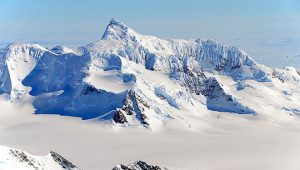
Credit: Michael Studinger, NASA.
Here’s what it takes to conduct research in Antarctica if you’re BYU biologist Byron Adams:
- Get on commercial plane, fly 20 hours 50 minutes to Christchurch, New Zealand. Eat, sleep.
- Get on C-17 plane, fly 6 hours to McMurdo Station, Antarctica. Eat, sleep, sort gear.
- Get on bush plane, fly 5 hours to a fuel cache in the middle of nowhere, Antarctica.
- Deplane, dig up barrels of fuel, pump fuel.
- Get back on bush plane, fly 5 more hours even further into the heart of Antarctica.
- Climb several hundred yards in freezing temperatures to a summit in the Transantarctic
- Mountains. Try to find out how microscopic creatures survived the ice age.
“Maybe they just survived frozen for 20,000 years—went into cryptobiosis and shut down until the Pleistocene [ice age] was over,” Adams said. “It’s still a mystery how life survived here. They did, but it’s still unsolved.”
Adams has spent many bone-chilling months in Antarctica trying to solve this riddle, digging up creatures like tardigrades, nematodes and rotifers to find out how they lasted. His latest work, published in Nature’s Scientific Reports, rules out one possible scenario.
Here’s the cliff notes version: During the last ice age, ice sheets were so expansive they covered the entire continent, making Antarctica unsuitable for terrestrial life. But biologist like Adams have found unique species of soil creatures native to Antarctica that somehow survived. Now he’s trying to find where they hid, or what they did to make it through the ice age.
And while his biological work in the coldest place on Earth is second to none, his efforts in getting there are equally impressive. The research he is publishing now started some 10 years ago with a grant proposal to the National Science Foundation.
Several complicated years later, Adams was finally granted 12 flights from McMurdo Station to locations where the tiny invertebrates might have hunkered down for the ice age. Although his grant proposal reviewed well, there were concerns about whether or not it was even possible to access these remote locations.
“I had to get a bunch of satellite imagery and talk to the pilots themselves and say, ‘Would you land me here?'” Adams said.
Turns out the pilots were willing, but the NSF was unsure. It wasn’t until Adams got access to flight photographs from the 1950s that he was able to convince the authorities that the planes could land safely.
“As it turns out, it was super easy,” Adams said. “The pilots would not only land on the glacier, they would fly their planes right up to the top where we needed to be. At one location we only had to walk about 50 feet to the sample areas.”
Walking only 50 feet was nice on both the researchers and the environment: “You walk some place and your footsteps will be there for 100 years. It’s the most pristine environment on the planet and all the damage that’s done is done by scientists. So we have to be very careful.”
Thus the strict rules on how many people can be there and how often they can be there, and the ban on the use of ground vehicles—no ATVs, not trucks, only helicopters.
Unfortunately, poor weather limited Adams to only three of the 12 approved flights, and only a few hours at each site. That was still enough time for Adams to collect sufficient soil for testing.
What he found was a bit disappointing: these potential “refugia,” or hideout spots for the tiny organisms, were not suitable for life. The locations had accumulated toxic levels of nitrogen because there was no plant life to consume the nitrogen.
“These habitats have basically sucked for like five million years,” Adams said. “If you were a little nematode worm, you wouldn’t survive on Brown’s Butte on the Beardmore region. You’re just not going to make it in those conditions.”
And so the search will go on. Adams will be back in Antarctica soon, probably during the summer months from December to February when the temperature stays in a relatively nice range of 18 to 33 degrees Fahrenheit.
Reference:
W. B. Lyons et al. The Soil Geochemistry in the Beardmore Glacier Region, Antarctica: Implications for Terrestrial Ecosystem History, Scientific Reports (2016). DOI: 10.1038/srep26189
Note: The above post is reprinted from materials provided by Brigham Young University.










